Motorcycle trivia buffs already know that the word breva refers to the southerly winds that blow over Lake Como-adjacent to Guzzi’s historic Mandello del Lario factory-bringing fair weather and good riding conditions to this blissful mountainous region just south of the Swiss border.
However, the saga of Moto Guzzi’s Breva began in Italy just a few years ago-when the company was clinging to the edge of a financial precipice-with the introduction of the 2004 Breva 750. Thanks to an infusion of capital from new parent company Piaggio, the Guzzi factory was able to go on and develop this bigger Breva 1100, too.
Rodolfo Frascoli of Marabese Design Studio penned the new Breva following a design concept for a modern naked tourer using Guzzi’s traditional longitudinal V-twin. Frascoli incorporated some of the Breva 750’s looks along with retro styling cues from an earlier Moto Guzzi naked tourer, the V7 Special. Designed in the late 1960s mainly for the American market, the V7 was powered by a 757cc version of the Guzzi V-twin. Its basic lines are now carried into the 21st century by the Breva V 1100, which is motivated by the 1,064cc “big block” version of the company’s classic V-twin.
Our test bike had the eye-grabbing bright-red color scheme, which just looks right on an Italian machine. More conservative black and gray are also offered, but the crimson hue has wide appeal among the public and cognoscenti alike. “Nice bike” we were often told, when the Breva was stopped for errands, parked outside the local Starbucks, or while refueling.
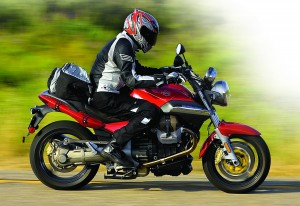
Power for the Breva comes from the same engine used in the Griso 1100. This robust and proven powerplant layout, which originally dates back to 1967, uses Moto Guzzi’s time-honored, air-cooled, 90-degree longitudinal V-twin. It’s a rather conservative design, with two valves per cylinder, and pushrods opening the overhead valves. On this latest version, the pistons, rockers and pushrods have been lightened to improve “revability.” There’s also twin-spark ignition, which employs two spark plugs per cylinder to better light the fires. Stirred to life by a starter motor larger than the one in my car, and powered by a hefty 18 amp-hour battery, the big Guzzi cranks over nicely.
Its new Weber-Marelli fuel injection eliminates the need for a manual cold-start control and the motore came to life quickly each time the starter button was thumbed. Initially the engine rocks back and forth a bit more when cold, but it is ready to go in seconds and exhibits very good rideability, with nary a cough nor stutter at any time. There’s a fair amount of valve clatter, but as they say, it adds character.
Strapped onto the Borla Performance Dynojet dynamometer, the Breva spun up 71.7 rear-wheel horsepower at 7,400 rpm and 56.3 lb-ft of torque peaked at 5,500 revs. As you can see on the graph, torque output is fairly steady from about 2,700 through 7,000 rpm, where it starts to taper off. Redline arrives at 8,000 rpm and there’s an adjustable rev-warning indicator incorporated into the tachometer that can be preset to a lower speed if desired.
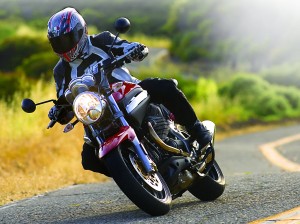
Thanks to the torquey nature of the V-twin, the bike feels like it has more power than the dynamometer indicates. The engine’s broad, relatively flat torque curve delivers a pleasing responsiveness, with plenty of acceleration and passing power on tap between about four grand and redline. With a top speed near 125 mph, there’s enough kick to keep all but the inveterate speed demons among us happy. Throttle response is quick, but not abrupt coming off idle. Upshifting early doesn’t seem to carry much of a penalty in performance, so for most riding we kept the tach under six grand. A pleasing growl emanates from the air intake and exhaust, particularly under hard acceleration. Above idle the valve clatter and moderate side-to-side shaking quickly melt away and the engine smoothes out nicely, with only the low-frequency throb of a big twin to accompany you, and no annoying buzziness.
Guzzi utilizes a twin-plate dry clutch to feed power from the engine to a six-speed gearbox. Its hydraulic actuation requires only moderate effort, and hookup is solid, while an adjustable lever tailors the reach for different size hands. With a shorter range of engagement than most wet clutches, it takes some getting accustomed to. There’s also a fair amount of clutch rattle when the lever is pulled in while the engine is idling-as expected with Italian dry clutches. Hey, it’s that character thing.
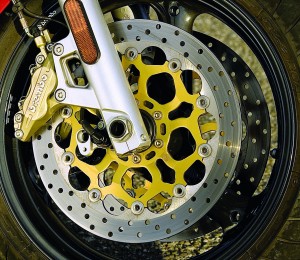
Shifting is solid and effective with consistent gear changes and no missed shifts or false neutrals. Neutral is also readily accessed, even when stopped in gear. First gear’s ratio is a bit tall, especially when starting on a hill riding two up with luggage, negotiating switchbacks or in stop-and-go traffic. Spacing between the other ratios is good, the gears are quiet, and sixth is tall enough to permit very relaxed cruising at higher speeds, with only 3,400 revs at 60 mph in top cog. Lug it down much below that and the engine gets lumpy in sixth gear, necessitating a downshift. Call it character.
Guzzi’s Compact Reactive Shaft Drive eliminates fussing with chains and does a great job of canceling out torque reactions that tend to vary ride height of shaft-drive machines. There is some driveline lash noticeable at low speeds, but it goes away as speed increases and there’s no palpable torque reaction when the throttle is opened wide.
With the Alps and Dolomites surrounding the Guzzi factory, it’s no wonder that handling is a priority. The Breva loves to change direction and is uncannily easy to turn, with a sharp turning radius and steering that feels much lighter than it has a right to. Rake and trail are mild, so part of the credit goes to the tall, wide handlebars, some to the effects of the longitudinal crankshaft layout. Despite the quickness at low speeds, the bike still holds a steady line through corners without constant corrections and feels solid and planted at highway speeds-the best of both worlds.
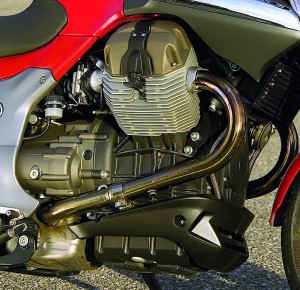
Three different tire models are offered as original fitment; Metzeler’s Roadtec Z6, Dunlop’s D220 ST and Michelin’s Pilot Road. Our bike had the Michelins, which wore well, gripped nicely in rain and dry conditions, were stable at high velocities, and even in squirrelly rain grooves they tracked true.
Lean the Breva over hard and the first thing that scrapes is the hefty centerstand, but most riders aren’t likely to touch down often and it’s nice to have a stand. The sidestand has one of the oddest bends we’ve ever seen, but it’s sturdy and gets the job done, too.
The Breva’s conventional 45mm fork is only adjustable for spring preload. Its plush spring rate delivers a cushy ride, but allows considerable dive under braking and feels like it could use more damping. In back, a solo shock offers both spring preload and rebound damping adjustments. An aluminum single-sided swingarm carries the enclosed final drive and makes tire changes a snap. In contrast to the front end, the rear feels too stiff and harsh and suffers from high unsprung weight due to the shaft-drive setup. We’d like to see more adjustability in the suspension, but overall it produces a respectable compromise of ride and handling in everyday use.
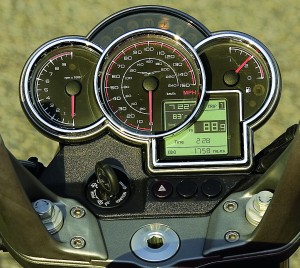
A pair of Brembo opposed four-piston calipers gripping 320mm floating rotors ably handle stopping duties in front, while a single disc with a two-pot pin-slide caliper resides in back. The brakes consistently deliver tremendous stopping power without fade, squeal or chattering. Moto Guzzi says ABS will be available as an option soon and our test bike already had the mounting points for the switch and sensors. Several other practical options are offered, including a windscreen, heated grips, hard luggage and a lower seat. These items can readily transform the Breva into a very competent touring machine.
The rider’s “office” is quite comfortable, with an upright riding position and tall handlebars that permit a natural riding position. Wide-set mirrors deliver plenty of vibe-free vision aft. That wide front portion of the seat rivals the best touring machines’ saddles, spreads out your weight and allows ample wiggle room. The rider’s footpegs are located slightly aft, which helps you lean into the windblast. Passenger accommodations are a little more cramped, but reasonable, with footpegs close to the rider’s, a moderate-sized pillion and large hand rails. Under the lockable one-piece saddle is a small storage area with much of the space taken by the fuel vapor-recovery canister.
Mounting a magnetic tankbag is out of the question because of the plastic gas tank cover, but strap-type bags can be used. We were able to install soft luggage and there are sufficient anchor points, including the passenger footrest brackets, which are designed to hold the factory hardbags.
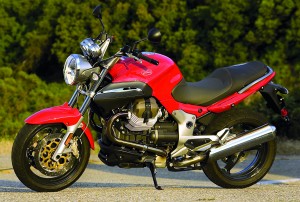
There’s no windscreen, but the high-mounted dash cluster helps break up the windblast somewhat. Guzzi’s development team put considerable effort into the instrumentation, with its three semi-circular analog gauges and adjoining rectangular LCD panel. Besides the 150-mph speedometer, dual tripmeters, 8,000-rpm-redlined tach and the usual indicator lamps, you’ll find an accurate fuel gauge, along with digital readouts for ambient temperature, lap timer, instantaneous and average fuel mileage, a clock and even battery voltage. Getting everything set the way you want is not easy, as the 10 pages devoted to it all in the owner’s manual can attest, but the dash looks great, especially when bathed in red light at night. Fuel mileage varied from a low of 34.7 to a high of 47.3 mpg, with an average of 41.0. With that big 6.1-gallon tank comes long range-the low-fuel indicator usually waits until 200 miles have elapsed to pop on.
During the time we had the Breva the only glitch was a minor one that occurred during a late-spring downpour. Apparently, rain got into the four-way flasher switch (which forms a well that traps water) and caused the signals to come on by themselves, er, adding character. They wouldn’t shut off for a while and just as we started to disconnect the battery the rain stopped and the switch began working again. Otherwise, the Breva proved to be a sturdy, trusty mount with ample power and braking, excellent fit and finish and attractive styling. We were particularly enamored by the Breva’s light, easy handling and good road manners, its comfortable ergonomics and the bike’s overall fun factor. While it may not be the fastest or the cheapest bike in its class, it will be difficult to find a well-rounded competitor which does as many things as well as the Breva. And did I mention character?








Thank you for a very informative article. I am trading in my very unreliable 2011 Ducati Multistrada Pikes Peak 1200S, for this exact bike, and I can’t wait ! The Multistrada is fast and has lots of electronic tricks and suspension modes, engine modes, etc etc, but you just can’t relax living with a bike which is constantly having faults. I have owned mine for one year and had a different problem each time I start the thing. I think the Guzzi will do everything I need but be reliable and soulful 😀